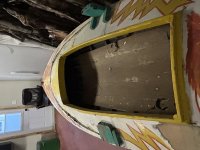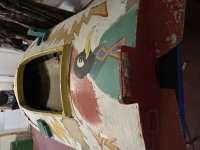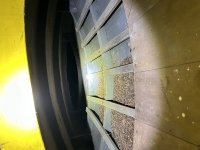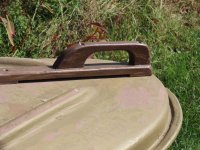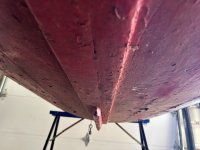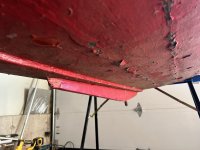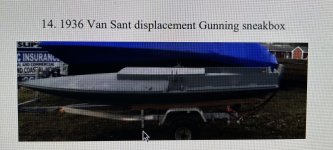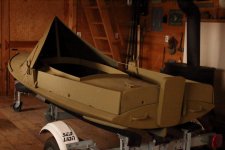Interesting photos....
The interior shots show she was built very traditionally, with carvel planking, not strip built. Carvel planking is where each plank butts tight to its neighbor - as opposed to lapstrake (aka "clinker-built") where each plank overlaps the upper edge of its neighbor. These 2 methods require very careful shaping of each plank.
Strip-building uses narrow strips (usually about an inch wide) that are nailed edgewise to each other.
Your planks - and frames - are probably White Cedar (Atlantic White Cedar v. Northern White Cedar). Your frames - both deck beams and floors - are sawn, not steamed. Each frame is sawn to a simple radius; such Sneakboxes are known as "arc-bottomed" (whereas some have a bit of U-shape to them). Again, this is the most prevalent construction for Barnegats. As the gussets and struts on each frame are lumber and not plywood, a pre-WW II build date seems likely.
I wonder if the plywood decks are original. Plywood did not become readily available until after WW II. Many traditionally planked small craft - including gunning boats - covered the planking with painted canvas to keep them watertight - especially when exposed to a drying sun. Perhaps cedar planking was replaced with plywood at some point over the boat's lifetime.
Your photo of the transom has me baffled. What am I looking at? The dark area in the middle of the reddish transom looks like a tunnel. (Which I know of only in much larger inboards used in shallow waters.) Got another photo of the transom that illuminates the area/shape?
re getting her in shape: Most gunners 'glassed Sneakbox hulls once the technology became available post WW II. Nevertheless, your vessel could be watertight as is - or at least once she was allowed to soak up some moisture - saltwater is best - to swell the planks and close any open seams. The decks, too, could be watertight - or made to be so with a bit of attention. Bear in mind, though, that traditionally-built boats were designed to live in or near water - and not on a trailer. Glass makes trailering traditional vessels a reasonable proposition.
If it were my boat, I would likely:
1) Glass the whole vessel top and bottom - with cloth (weight depends on hull condition) set in epoxy.
2) Sew a spray dodger and make a pole to support it.
3) Replace all the steel/iron hardware with galvanized or s/s (or bronze if you're lucky or wealthy). Some pieces - like lifting handles on bow or stern - can be made from wood. I just made this bow handle from White Oak (mounted on a treated lumber thatch rail):
View attachment 59597
4) Make a new motor board that would safely and soundly support any outboard you wanted to put on her. If you plan to row, I'd remove the existing motor board altogether.
5) Decide if you want thatch rails or other means of fastening "camouflage" to the decks.
6) Add minor features like backrest, shelf, gun rest, lap cover,
et cetera once you decide how you will hunt her.
Hope this helps!
SJS
 says her father and mother hunted out of it quite often. She thinks it is 90 years old.
says her father and mother hunted out of it quite often. She thinks it is 90 years old. says her father and mother hunted out of it quite often. She thinks it is 90 years old.
says her father and mother hunted out of it quite often. She thinks it is 90 years old.

